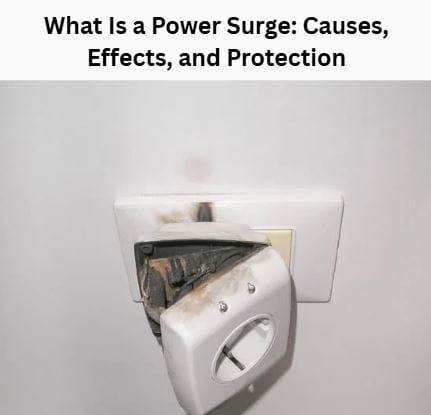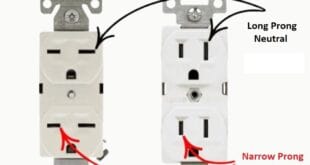What Is a Power Surge: Causes, Effects, and Protection
Introduction
Electricity powers nearly every aspect of modern life—from lighting homes and charging phones to running computers and appliances. While our electrical systems are typically stable, they are not immune to unexpected spikes in voltage known as power surges. These brief increases in voltage can cause significant damage to electronic equipment, shorten the lifespan of devices, or even create fire hazards.
This article explains what power surges are, explores their causes and effects, and outlines how students, homeowners, and technology users can protect their electronics and property from damage.
1. What Is a Power Surge?
A power surge, also called a voltage spike or transient, is a short, sharp increase in voltage that flows through an electrical circuit. In most homes, electricity is supplied at a consistent voltage—120 volts in North America and 220–240 volts in many other countries. A surge happens when the voltage briefly rises above this normal level, sometimes reaching hundreds or thousands of volts. These surges typically last a few microseconds, but they can cause long-lasting or immediate damage.
Surges occur more often than most people realize. While many are too minor to notice, repeated small surges can gradually wear down electronics, and large surges can destroy them instantly.

2. Common Causes of Power Surges
External Causes
1. Lightning Strikes
One of the most dramatic causes of a power surge is a lightning strike. A bolt of lightning near a power line can inject an enormous amount of voltage into the grid, overwhelming household wiring and electronics.
2. Utility Switching and Grid Faults
When the power company switches electrical loads or experiences equipment failures, the sudden change can cause a voltage spike that reaches homes.
3. Power Restoration After Outages
After a blackout, the sudden restoration of electricity can create a large surge. When power “rushes” back into a system, it may temporarily overwhelm connected devices.
4. Damaged Power Lines or Transformers
Accidents, fallen trees, or weather events can damage external electrical infrastructure. When the damage is repaired or the system attempts to rebalance, a surge may occur.
Internal Causes
1. High-Powered Appliances
Large appliances such as refrigerators, air conditioners, and washers can create small surges when they cycle on and off. This happens because they draw large amounts of power to start.
2. Faulty Wiring
Old, damaged, or poorly installed electrical wiring can cause fluctuations in current. These irregularities increase the risk of surges and electrical fires.
3. Electrical Overloads
Plugging too many devices into a single outlet or circuit can overwhelm the system, resulting in overheating or voltage spikes.
4. Switching Devices and Motors
Office equipment, elevator motors, and other high-induction devices can cause internal voltage fluctuations as they operate.
3. Characteristics and Frequency
Power surges vary in their intensity and duration:
Amplitude: Some surges are just a few volts above normal, while others—especially those caused by lightning—can spike to tens of thousands of volts.
Duration: Most surges last for only a few microseconds to milliseconds.
Frequency: Most buildings experience small, daily surges that go unnoticed, but major surges are less frequent and more dangerous.
4. Effects of Power Surges
Power surges can damage electrical systems in different ways, depending on their severity.
1. Immediate Damage
A strong surge can instantly fry electronic circuits, blow fuses, or cause devices to fail without warning. Computers, televisions, routers, and kitchen appliances are particularly vulnerable. Can a Power Surge Destroy Your Devices?
2. Gradual Component Degradation
Even minor surges can weaken internal components over time. Repeated exposure can shorten the lifespan of electronics and cause unexpected breakdowns.
3. Data Loss and Corruption
A sudden surge can interrupt a computer’s operation, potentially leading to file corruption, operating system crashes, or permanent data loss.
4. Fire Hazards
In extreme cases, especially in homes with old or faulty wiring, power surges can cause heat buildup that sparks fires.
5. Subtle Warning Signs
Not all surge damage is obvious. Some signs include:
Flickering or dimming lights
Electronics that randomly reset or shut off
Burnt smells or discoloration around outlets
Tripped circuit breakers or blown fuses
5. How to Tell If You’ve Experienced a Surge
Here are some indicators that a power surge may have occurred:
| Symptom | Possible Cause |
|---|---|
| Flashing digital clocks | Power interruption or spike |
| Devices reboot unexpectedly | Short-term voltage spike |
| Buzzing sounds from outlets | Loose wiring or voltage fluctuation |
| Scorched or warm wall sockets | Surge or electrical overload |
| Appliances stop working suddenly | Surge-related component failure |
6. How to Protect Against Power Surges
1. Use Surge Protectors
The most basic and effective way to guard against surges is to use surge protection devices (SPDs). These devices detect spikes and divert excess energy to the ground.
Types of Surge Protectors:
Power Strip Surge Protectors:
These look like regular power strips but include surge protection features. Look for a joule rating (higher is better) and UL 1449 certification.Uninterruptible Power Supplies (UPS):
UPS systems provide backup battery power during outages and often include built-in surge protection, making them ideal for computers and network devices.Whole-House Surge Protectors:
These are installed at the main electrical panel and protect your entire home from external surges. They are especially effective in areas prone to lightning.
2. Upgrade Electrical Wiring
Old or faulty wiring increases the risk of surge damage and fire. Regular inspections by a licensed electrician can identify problems and recommend upgrades.
3. Unplug Devices During Storms
During severe weather, unplugging sensitive electronics is a simple and effective way to avoid damage from lightning-induced surges.
4. Spread Out Electrical Load
Avoid plugging too many high-powered devices into one outlet. Use different circuits to distribute the electrical load evenly.
5. Install Dedicated Circuits for Large Appliances
Large appliances should be on their own circuits to reduce the chance of internal surges affecting sensitive electronics on the same line.
6. Maintain and Replace Surge Protectors
Surge protectors wear out over time, especially after a large surge. Many have indicator lights showing their status—replace them if they’re no longer working.
7. Protecting Specific Devices
Different types of equipment need tailored protection strategies:
Computers and Laptops
Use a UPS with both surge and backup power capabilities. Regularly back up important files to the cloud or an external hard drive.
Smartphones and Tablets
Use surge-protected charging stations or USB surge protectors, especially in areas with unstable electricity.
Televisions and Entertainment Systems
Use surge strips with a high joule rating and space for bulky adapters. Avoid plugging directly into the wall.
Kitchen and Laundry Appliances
Install whole-home surge protection to guard high-powered equipment like refrigerators, dishwashers, and washing machines.
Modems and Routers
These should also be connected to surge protectors to prevent damage that could knock out internet service.
8. Surge Protection for Larger Facilities
In schools, dorms, labs, or offices, protecting equipment is even more important due to the number of devices and the cost of potential downtime. Strategies include:
Installing SPDs at every panel or distribution point
Using commercial-grade UPS systems
Regular maintenance and inspection of electrical infrastructure
Training staff to disconnect or isolate equipment during electrical disturbances
9. Key Takeaways for Students
A power surge is a brief spike in voltage that can damage electronics.
Surges can be caused by lightning, power company issues, appliances, or faulty wiring.
Effects include device failure, data loss, component degradation, and even fires.
Protect your equipment using surge protectors, UPS devices, and whole-home systems.
Maintain wiring, unplug during storms, and spread out high-load devices to reduce surge risk.
Conclusion
Power surges are a common but preventable problem. They may be brief, but the damage they cause can be long-lasting and costly. Whether you are a student managing your digital devices or someone looking to protect your home or office, understanding what causes power surges and how to defend against them is essential. With the right strategies, you can reduce your risk, protect your electronics, and ensure safety and reliability in your electrical systems.
 Electrical Engineering World Wiring a Brighter Tomorrow!
Electrical Engineering World Wiring a Brighter Tomorrow!


